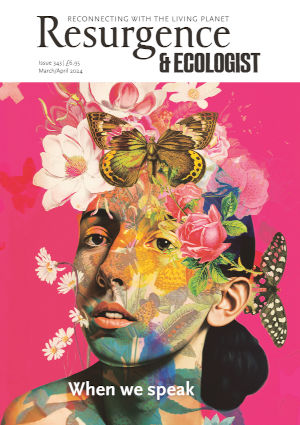It took the Royal Academy more than 250 years to present its first solo show by a woman. Not until 2023 did performance artist Marina Abramović break the march of male artists. One wonders what kept the Royal Academy so long. It is an omission indicative of the systemic erasure of pioneering female artists that a new book seeks to redress.
Mothers of Invention: The Feminist Roots of Contemporary Art reappraises women’s role in reinventing contemporary art practice. Four scholars take a chapter each to dive into how women artists drove forward a movement: performance, abstraction, craft and ecofeminism. Across these disparate practices the shared theme is that, by operating at the margins of contemporary practice, women were free to take risks and push art in new directions. Art history excluded and sidelined this innovative impulse, keeping women firmly in their place at the edges. Now, say the authors, the fruits of female inventiveness have migrated into the mainstream, and it is high time their contribution were recognised.
An image of Abramović in her seminal work Rhythm 0 (1974) opens Helaine Posner’s chapter on performance art. Posner traces the evolution of the form from confrontational works by Carolee Schneemann and Yoko Ono, through Cindy Sherman’s and Carrie Mae Weems’ experi-ments with identity, to Russian collective Pussy Riot. She sets the evolution of performance art against the political ferment of the sixties and seventies as performance-blurred distinctions of artist and audience, “forcefully confronting the mainstream art world’s exclusionary practices”.
The vulnerability of the female body is central to the pol-itics of feminist performance art, and it remains a high-risk strategy. When 25-year-old Abramović put her naked body at the mercy of her audience, after the performance of Rhythm 0 her hair turned white. In 2017, members of Pussy Riot were arrested by Russian state police and jailed.
Nancy Princenthal picks up the theme of embodied practice in her chapter on craft. This most tactile of forms has long languished at the margins of art practice. In a status-obsessed art world, craft has been a sideshow – “a kind of lagoon”, in Grayson Perry’s eyes. Even the ostensibly egalitarian Bauhaus established a hierarchy of practices, with textiles (and women) at the bottom. No wonder artists like Agnes Martin distanced themselves from low-status fibre art. Yet, Princenthal shows, this lagoon contained fertile waters where artists as distinct as Judy Chicago and Magdalena Abakanowicz could challenge the boundaries of practice. So much so, that now ceramics and textiles fill art galleries in western capital cities, and command record prices at art fairs.
The exquisite quilts made in Gee’s Bend, Alabama, are emblematic of this shift to the mainstream. Drawing on motifs developed by enslaved ancestors, Gee’s Bend quilts are at once artefacts of resistance, torchbearers of tradition and radically inventive works of art. Their “jazzy geometry” was described in The New York Times as “some of the most miraculous works of modern art America has produced”.
Arguably, abstraction is the most difficult form to fit into a feminist narrative. “How do we discuss abstraction in a feminist context, if content is essential to feminist art?” asks Sue Scott in her chapter. Her answer, drawing on tactics employed by artists such as Hilma af Klint, is that innovation of form is itself a feminist act in a male-dom-inated realm.
For these authors, no category is rigid or fixed. They acknowledge the interweaving of domains – the “impurity, instability and hybridity”, in Eleanor Heartney’s phrase. Like Anni Albers’ sublime woven artworks, Gee’s Bend quilts bridge craft and abstraction; many ecofeminist artists use performance as their primary creative tactic. This entanglement is, they argue, feminist in its urge to move beyond binaries to a more nuanced, multivalent, many-voiced conception of art.
This notion of interconnectivity, and of the Earth as a living, entangled, interdependent system is, says Heartney, precisely what makes ecofeminism feminist in its rejection of human dominionism, and its understanding that humans do not stand outside of Nature. This is the impulse behind such works as Agnes Denes’ Wheatfield – A Confrontation in which the artist planted two acres of wheat on a landfill two blocks from the World Trade Center in New York City, and Mierle Laderman Ukeles’ Maintenance Art, both artistic interventions in the urban environment that serve equally as provocation and as acts of care. As it happens, Denes and Ukeles both featured in the Barbican’s RE/SISTERS, a survey show of ecofeminist art that coincided with Abramović at the Royal Academy.
As they recast the narrative of women as artistic invent-ors, the authors pause to consider what has stood in the way of women’s artistic progress, from male domination of art education and criticism to the challenges of combining motherhood and art. These challenges have not yet disappeared, as critic Hettie Judah pointed out in her 2022 book on the topic. Still, let’s hope it won’t be another quarter of a century before the Royal Academy sees fit to stage a solo show by a woman artist.
Recasting the narrative of women as artistic innovators, Mothers of Invention ends on a note of hope: women’s power to invent and reinvent is what will save us from pessimism and despair. As Virginia Woolf wrote in The Waves, “I am made and remade continually.”
Mothers of Invention: The Feminist Roots of Contemporary Art by Eleanor Heartney, Helaine Posner, Nancy Princenthal & Sue Scott. Lund Humphries, March 2024. ISBN: 9781848225404.







